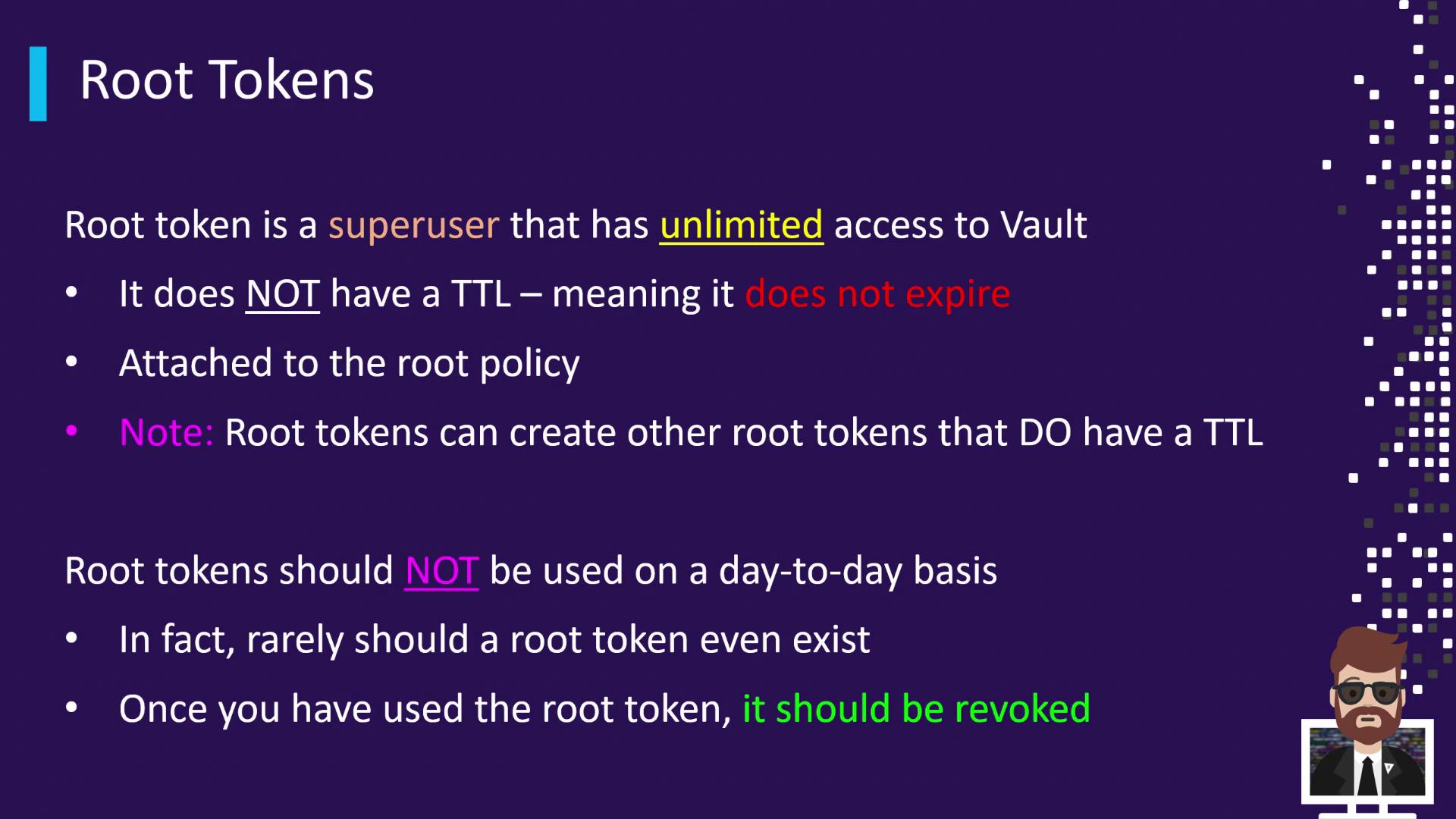HashiCorp Certified: Vault Associate Certification
Assess Vault Tokens
Root Tokens
In Vault, a root token is the ultimate superuser credential. It carries the root policy, granting unrestricted access to every Vault operation. This guide covers what root tokens are, how to use them securely, and the various ways to generate or recover them.

What Is a Root Token?
A root token:
- Carries the
rootpolicy, allowing any Vault operation - Is non-renewable by default (
token_renewable=false) - Has no expiration (TTL is ∞)
Running a lookup against a root token shows:
$ vault token lookup s.<root-token>
Key Value
--- -----
token s.<root-token>
token_duration ∞
token_renewable false
policies ["root"]
Note
You can use an existing root token to create a new token with a finite TTL if desired.
Best Practices for Root Tokens
Root tokens should be handled with extreme caution:
| Scenario | Usage |
|---|---|
| Initial Setup | Perform your Vault initialization tasks. |
| Testing Integrations | Validate new auth methods (e.g., LDAP, OIDC). |
| Emergency Recovery | Regenerate in a crisis when standard auth is unavailable. |
Warning
Root tokens grant unlimited access. Always revoke them immediately after use to avoid security risks:
$ vault token revoke s.<root-token>
Success! Revoked token (if it existed)
Generating Root Tokens
You can obtain a root token through three primary methods:
| Method | When to Use | Command |
|---|---|---|
| Initialization | First-time Vault setup | vault operator init |
| Using an Existing Token | Create additional root-level tokens | vault token create |
| Using Unseal/Recovery Keys | Emergency recovery when Vault is sealed | vault operator generate-root |
1. Initialization
During Vault initialization, the CLI outputs your initial root token:
$ vault operator init
# ...
Initial Root Token: s.<initial-root-token>
# ...
2. Creating from an Existing Root Token
If you already have a root token, log in and issue a new one:
$ vault login s.<existing-root-token>
Success! You are now authenticated.
$ vault token create
Key Value
--- -----
token s.<new-root-token>
token_duration ∞
token_policies ["root"]
policies ["root"]
3. Emergency Recovery with Unseal/Recovery Keys
In critical scenarios where Vault’s normal auth is down, you can regenerate a root token using a quorum of recovery keys.

Step 1: Initialize Root Generation
Generate a nonce and one-time password (OTP):
$ vault operator generate-root -init
Nonce 5b6e3831-2a45-4695-7757-5810074d36c8
Started true
Progress 0/3
Complete false
OTP E87jF6ZeJo8NjJwytl7mvKLER
OTP Length 26
Step 2: Submit Unseal Keys
Each key holder submits their unseal key. Repeat until the threshold is met (e.g., 3/3):
$ vault operator generate-root
Root generation operation nonce: 5b6e3831-2a45-...
Unseal Key (will be hidden):
Progress 1/3
Complete false
Step 3: Decode the Root Token
Once the threshold is reached, use the OTP to decrypt the encoded token:
$ vault operator generate-root \
-otp="E87jF6ZeJo8NjJwytl7mvKLER" \
-decode="G2NeKUZgXTsYYxILAC9ZFBguPw9ZBovFAs"
Root token: s.<recovered-root-token>
After resolving the emergency, revoke the recovered root token:
$ vault token revoke s.<recovered-root-token>
Success! Revoked token (if it existed)
Key Takeaways
- Root tokens have unlimited privileges and no default expiration.
- Restrict use to initial setup, testing, or emergency recovery only.
- Always revoke root tokens immediately after use.
- Generate root tokens via initialization, an existing root token, or a quorum of unseal keys.
References
Watch Video
Watch video content